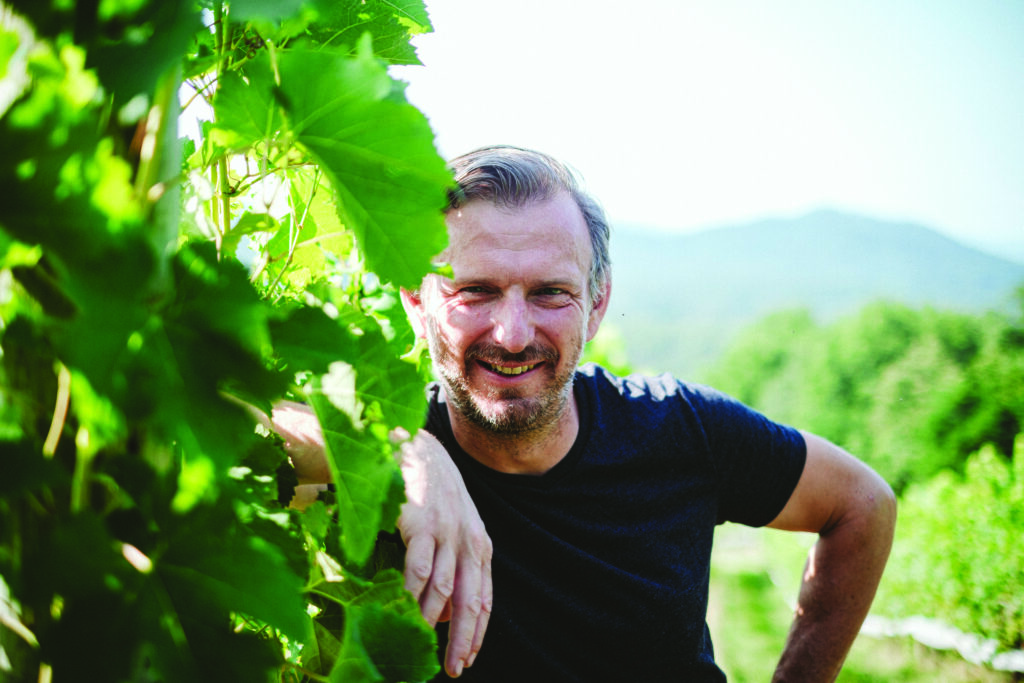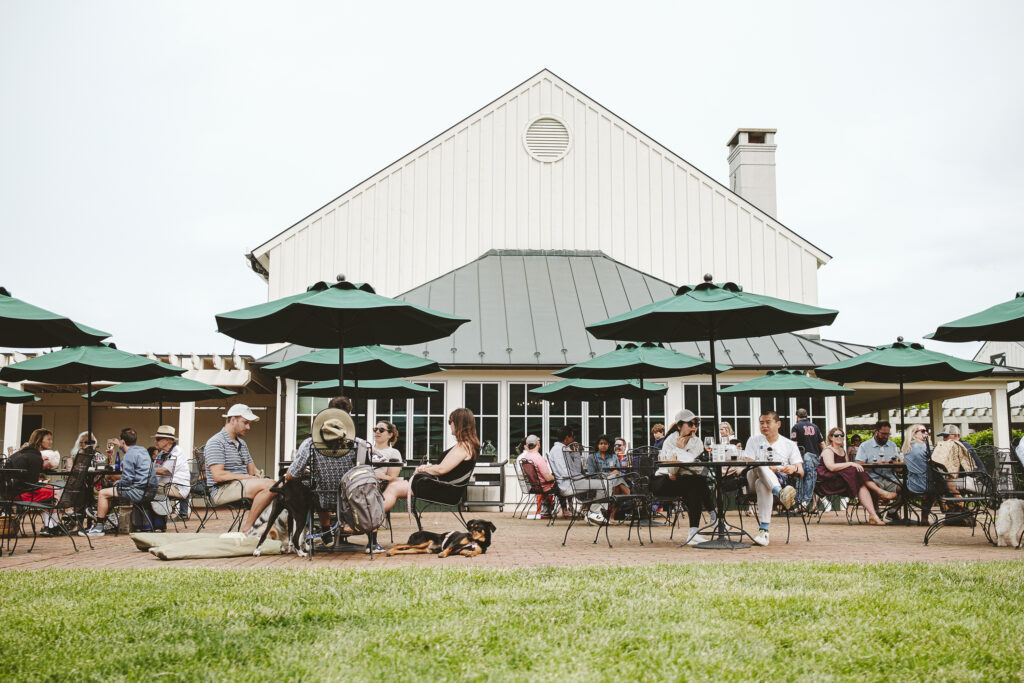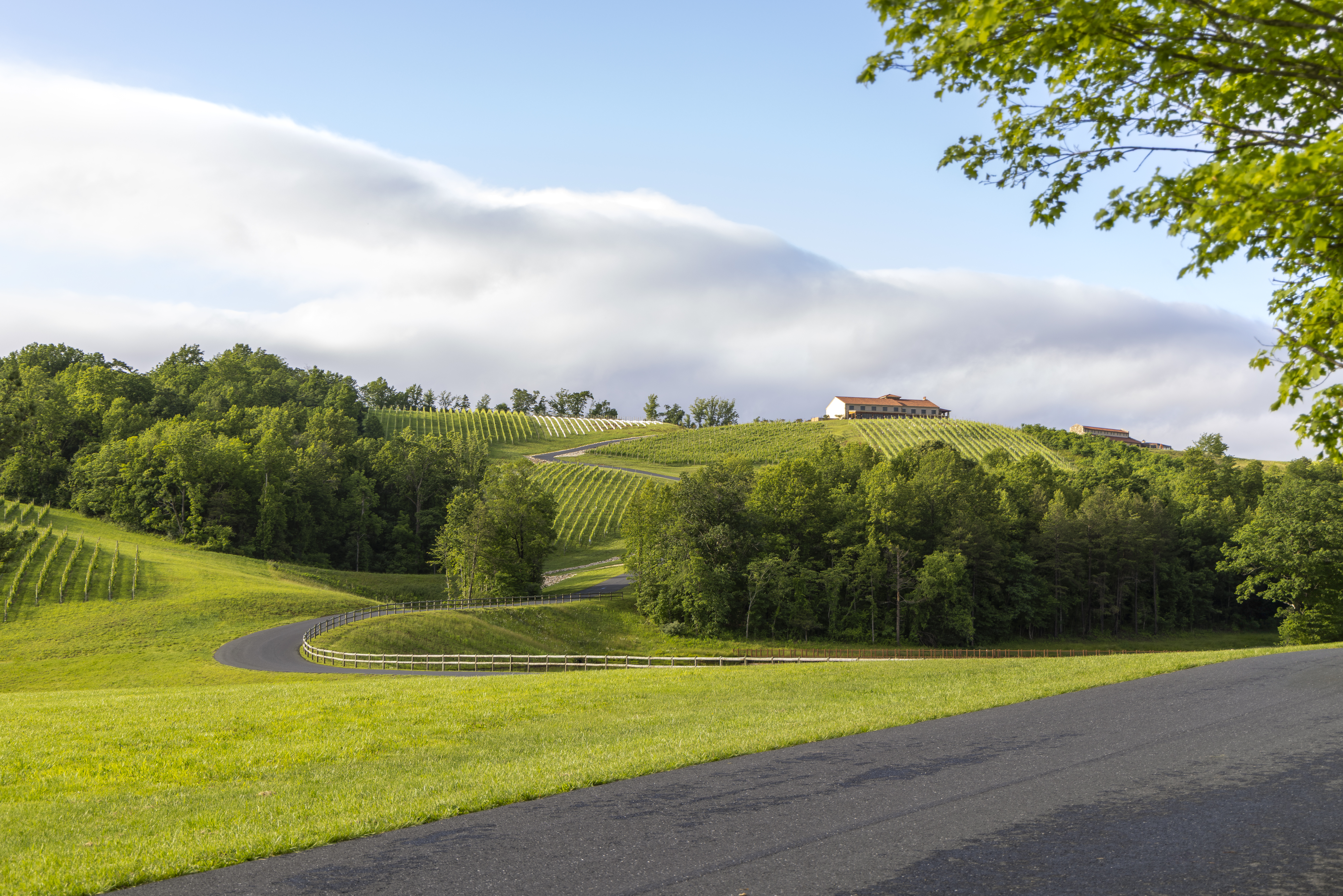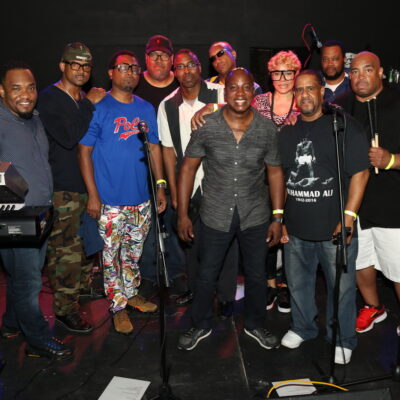Let’s all raise a glass to the Monticello American Viticultural Area, where the award-winning wines are why Charlottesville and its surrounding counties are bubbling over with oenophiles and oenotourism.
June 5 kicks off Monticello Wine Week, a celebration of the wines and wine producers of the five-county Monticello AVA. The program is sponsored by the Monticello Wine Trail, a cooperative marketing effort of 44 wineries within the region.
“We’ve been putting on special events for several years,” says Tracey Love, the Wine Trail’s marketing coordinator, “but last year was the first time we called it Wine Week.” The Monticello AVA was named 2023 Wine Region of the Year—one of only five wine regions nominated, and the only North American nominee—as part of the prestigious Wine Enthusiast magazine’s annual Wine Star Awards. “Now they’ve started designating one American and one international area, but at that time only one area of the world won,” says Love. “So we wanted to make a big splash.”
This year’s big splash will feature five events over a three-day weekend, all designed to showcase the breadth and quality of wines produced in this area. The program will kick off with two dinner events. The Winemaker’s Dinner at UP on the Rooftop at The Doyle Hotel, which includes a multi-course menu, paired with six award-winning local wines from Blenheim, Eastwood, Hark, Horton, Septenary, and Wisdom Oak vineyards. Winemakers for these wines will share their experience and insights about what makes the Monticello AVA special. Athena Eastwood, owner of Eastwood Farm and Winery and chairman of this year’s Wine Week, notes, “All the participating wineries for this event are women-owned or have women winemakers.”
Dinner at The Clifton will offer dishes stressing local sources prepared by Michelin-starred executive chef Matthew Bousquet and his team. Each will be matched with wines from Afton Mountain, Jefferson, Keswick, King Family, Michael Shaps, Pollack, and Veritas vineyards. Well-known local wine expert Erin Scala, owner of Market Street Wine, is hosting the event.
The gala Gold Medal Celebration and announcement of this year’s Monticello Cup winner is June 6 at The Bradbury on the Downtown Mall. Guest speakers include Frank Morgan, founder of the Drink What YOU Like website; George Hodson, CEO of Veritas Vineyard & Winery and president of the Monticello Wine Trail; and Virginia Secretary of Agriculture Matthew Lohr. Attendees will have the chance to meet the winemakers for the medal-winners, and share in the announcement of the Monticello Cup winner—the best of the best. With cuisine provided by Harvest Moon Catering, guests can select from at least a dozen of this year’s medal winners (all of them, Eastwood points out, made with 100 percent Monticello AVA grapes).
Matthieu Finot, King Family Vineyards’ winemaker and a Wine Trail board member, explains that every year Wine Trail members can submit their two best wines for evaluation as gold, silver, or bronze medalists. This year, 36 wineries submitted entries, and five of them had two gold medal winners (Barboursville, Chestnut Oak, King Family, Trump, and Valley Road). The 12 judges—all wine professionals such as sommeliers, wine-shop owners, and wine writers—are selected by Morgan, who is also director of both the Virginia Governor’s Cup and the Shenandoah Cup for our neighbor’s AVA.
“Any time you can get an award, a gold medal, people get excited,” Finot says. “But our members aren’t really competitors—it’s a way to show the public what is being made, a way to celebrate the richness of this area. And the participants get a copy of the judges’ comments [on their wine], so it’s a good way to learn how to make your wine better.”
Wine Week celebrations continue with two outdoor events on June 7. The Sparkling Brunch at Veritas Vineyard & Winery features a buffet, with a wide variety of sparkling wines from Afton Mountain, Hazy Mountain, King Family, Michael Shaps, Stinson, Trump, and Veritas vineyards. The winemakers will be there to talk about their wines, their vineyards, and the special characteristics of this AVA.
Just down the road, Afton Mountain Vineyards is the venue for a rosé picnic. Guests will enjoy gourmet box lunches from the chef at the Iris Inn in Waynesboro, along with rosés from Afton Mountain, Chiswell, Hark, Hazy Mountain, Jefferson, King Family, Lovingston, Stinson, Trump, Valley Road, and Veritas vineyards. Attendees are welcome to hang out in the vineyard’s outdoor pavilion or on the lawn, chatting up the winemakers and enjoying the mountain views.

New terroir
And yes, this all goes back to Thomas Jefferson, whose four-decade effort to establish a wine industry in Virginia may have failed, but whose love of Old World wines endures. Unfortunately, the only wine grapes native to North America are fox grapes, used for winemaking by Native tribes and early colonists but unsuited to making European wines. Jefferson recruited Italian winemaker Filippo Mazzei to come study Monticello’s terroir (its soils, climate and weather conditions, and topography), and in 1774, Mazzei began planting European grapevines he judged might produce here. The American Revolution interrupted that venture, but after independence was won, Jefferson recruited his neighbor and political ally James Monroe in his viniculture efforts. But they could not overcome this area’s hot, humid summers and cold winters, endemic diseases, and native pests like the insect phylloxera, which was inadvertently introduced to Europe in the 19th century on imported grapevines, and devastated the wine industry there.
Next up was Daniel Norborne Norton of Richmond, who in the 1830s successfully propagated a non-foxy native grape. Norton grapes became the foundation for Virginia claret, as well as for a widespread wine industry from Virginia to the Midwest. (Fun fact: Norton is now the state grape of Missouri.)
By the late 1800s, The Monticello Wine Company and other producers from this area were winning awards in Europe. The success of the local wine industry led Charlottesville to dub itself “The Capital of the Virginia Wine Belt.” In fact, a bottle from the Monticello Wine Company was used to christen the battleship U.S.S. Virginia in 1904.
With Prohibition, the wine industry in Virginia (and in most of the rest of the nation) dried up. Its recovery was spurred by the arrival of Gianni and Silvana Zonin in the 1970s. Their Barboursville Vineyards, John and Felicia Rogan’s Oakencroft Vineyards, and Rapidan River Vineyards (now part of Prince Michel) led the revitalization of this area’s wine industry. One of the most notable advancements came with the successful production of viognier grapes by Dennis Horton at a small Madison County vineyard in the 1980s; third-generation Horton Vineyards in Gordonsville now produces many award-winning wines from viognier as well as cabernet franc, syrah, and several other grape varieties, including norton. (Another fun fact: Viognier is Virginia’s state grape.)

Community spirit
The Monticello AVA now produces wines from at least 30 varieties of grapes at more than more than 50 wineries, and the number has increased year-over-year in the last decade. Most of these wineries are members of the Monticello Wine Trail, and all of them are located within 25 miles of Charlottesville. That’s wonderful news for wine lovers, wine shops, sommeliers, and restaurants—especially with the continued trend to eat and buy local.
And it’s a great draw for visitors. “Tourism is big business in Charlottesville and Albemarle County, generating nearly one billion dollars of direct visitor spending for the second year in a row,” according to the Charlottesville Albemarle Convention & Visitors Bureau in a September 2024 press release. One of the factors cited is “an internationally renowned wine scene.”
The bureau’s research shows that winery visitors are 50 percent more likely to spend the night in the area, adding to the economic impact. The diversity of local vineyards offer everything from family- and dog-friendly venues, food trucks, live music, and (in the case of King Family Vineyards) polo matches, to award-winning restaurants and accommodations at any level from mountain cabins to luxury hotels. And then there’s the event venue revenue generated by weddings (and bachelor/bachelorette weekends), family reunions and celebrations, alumni gatherings, mountain getaways, and more.
Collectively, the area’s wineries have been adapting to climate change by cultivating hybrid varieties, adopting sustainable practices, implementing solar panels and composting programs, and championing biodiversity in the vineyards. Oakencroft Vineyards, for example, has been reborn as Oakencroft Farm & Winery, a showcase for sustainable practices and regenerative farming, as well as a gathering place for environmental education.
The Monticello Wine Trail has also been active in promoting diversity and inclusion in the industry. Woburn Winery in Clarksville, opened in 1940 by John June Lewis, Sr., was the first Black-owned winery in Virginia (and maybe the country), while the Two Up Wine Down festival will be held in November on the lawn of the Jefferson School African American Heritage Center. Sponsored by the nonprofit Veraison Project and Blenheim Vineyard’s Oenoverse initiative, the annual event is dedicated to supporting diversity and highlighting the contributions of Virginia’s BIPOC wine professionals to the industry.
That community spirit was noted in the selection of the Monticello AVA as 2023 Wine Region of the Year. “Our members support each other,” says Love, evoking the spirit of a rising tide lifting all boats. One of the latest examples is the Virginia Wine Collective, Eastwood Farm and Winery’s newly opened facility on Avon Street in Charlottesville.

“It’s our main production facility,” says Eastwood, “and it’s also an incubator for other vineyards. It’s built with nine wine studios for independent winemakers who don’t have their own tasting rooms.” The idea is to provide a space where both established and start-up winemakers can offer their products, thus reducing their development costs and supporting further innovation and talent in the Monticello AVA.
Most important to these winemakers, wine lovers, and wine experts, however, is to have people experience and enjoy their products. Whether you want to immerse yourself in the world of terroir, vintages, and nose, or just want to relax with some friends, remember the words of another founding father, Benjamin Franklin: “Wine is constant proof that God loves us and wants to see us happy.”
Taking the wine trail
If all this reading about wine has made you curious, the Monticello Wine Trail website has a great feature for planning a wine-tasting road trip.
Pick an area: Feel like a day in the mountains? A drive on the back roads? A visit to the Barboursville Ruins?
Or start with some pre-research on what you’re seeking: Family-friendly? Live music? Brunch? Specialty wines you want to try?
Then use the site’s Planning Your Visit feature to click on the wineries you want to hit to get a preview of your route; it may be hard to cover Cunningham Creek (Palmyra), Flying Fox (Afton), Glass House (Free Union), and Woodbrook Farm (Orange) in one day.
The site will generate an easy-to-follow itinerary with addresses, phone numbers, directions, and driving times. Printing out directions may sound old school, but it’s useful—cell service is sometimes spotty out in the country.
Then enjoy your day, or weekend(s), of getting to know what the Monticello Wine Trail calls “the birthplace of American wines.”
Featured Image: Jeff Morgan






